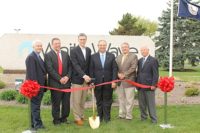WhiteWave Opens Company’s First Certified Green Manufacturing Plant

WhiteWave Foods, Broomfield, Colo., announced green building certification of its beverage manufacturing facility in Dallas, Texas. The facility, which produces  Silk soymilk, almondmilk and coconutmilk, Horizon Organic milk and International Delight flavored coffee creamers, earned U.S. Green Building Council (USGBC) LEED certification for New Construction. The 325,000-square-foot facility was built in 2012 and employs nearly 300 people.
Silk soymilk, almondmilk and coconutmilk, Horizon Organic milk and International Delight flavored coffee creamers, earned U.S. Green Building Council (USGBC) LEED certification for New Construction. The 325,000-square-foot facility was built in 2012 and employs nearly 300 people.
“WhiteWave is committed to changing the way the world eats for the better, and we recognize that how we make our products is just as important as what we make,” says Blaine McPeak, president. “Improving the environmental profile of our manufacturing process helps us to offer consumers more sustainable food choices and reinforces our commitment to reduce our environmental impact.”
Green attributes of the WhiteWave facility include:
- Nearly 90% of all demolition and construction waste associated with the project was diverted from landfills.
- Landscaping that requires no irrigation.
- Fixtures that use 30% less water.
- 100% of wood-based building materials certified sustainable by the Forest Stewardship Council (FSC).
- Nearly half of all building materials manufactured within 500 miles of the site.
- Use of materials and design techniques that facilitate solar reflectivity, helping to address “heat island” challenges associated with Dallas’ urban development.
The WhiteWave plant was designed by Hixson, based in Cincinnati, Ohio.
In fact, much of the credit for achieving LEED certification is due to the seamless working relationships between Hixson and WhiteWave, who had a passion to develop a sustainable facility, according to Bill Sander, senior vice president and project manager for Hixson.
“We implemented a master plan and complied with a schedule based on WhiteWave’s aggressive requirement for production of saleable product by a time-sensitive date,” adds Sander. “This required close collaboration and the use of the collective knowledge of the entire team, including the general contractor, to identify the long lead equipment issues, to overcome the difficulty associated with staged construction permitting and to keep a keen awareness of the LEED certification objective.”
Looking for a reprint of this article?
From high-res PDFs to custom plaques, order your copy today!




